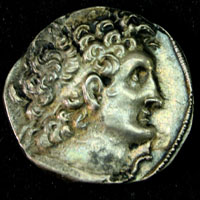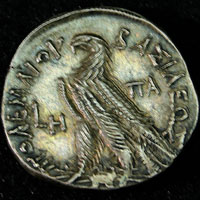Ptolemy IX Soter II (first reign 116-107 BCE), Silver Tetradrachm, 110/09 BCE
weight: 14.2g; width: 2.45cm; die axis: 11h


OBV.: Head of Ptolemy I Soter (305-285 BCE) wearing diadem and aegis right, set in dotted border.
REV.: Eagle sitting on a fulmen (winged thunderbolt of Zeus). Inscription above: "PTOLEMAIOU BASILEWS” (= Ptolemaiou Basileos, "of King Ptolemy). In left field, L and year "H" (8. year = 110/09 BCE). Mint mark on right: "PA" (= Alexandria).
HFMA nr. 2006.010.018. Ref.: BMC Ptolemies p.108 nr. 59-60 [plate xxvii.1]; Svoronos 1669 (attributed incorrectly only to Ptolemy X and Paphos); SNG Copenhagen 352; Nicolaou/ Mørkholm 1976, 91 (nr. 822-869, cf. plate XXI, 825).
This coin was minted during an especially eventful and troublesome period in the history of the later Ptolemaic Empire. When Ptolemy VIII Euergetes died, he declared his wife, Cleopatra III, ruler together with whomever of her two sons she should choose as co-ruler (1). Cleopatra's first choice was her younger and thus presumably more pliable son, Ptolemy Alexander, but the inhabitants of the capital, Alexandria, refused to accept him. In the face of revolt, she had to install her older son, then about 25 and for some reason nicknamed Lathyros ('chickpea'), as Ptolemy IX Soter II.
In the following years, Cleopatra repeatedly shuffled her sons between the posts of co-ruler of Egypt and king of Cyprus. In 107 BCE, Cleopatra successfully persuaded the people of Alexandria that Ptolemy Lathyros was trying to kill her. Ptolemy IX was driven out of Egypt, and his younger brother, Ptolemy X Alexander II, was installed as his mother's co-ruler. Their common coins showed now not only Ptolemy Alexander's, but also his mother's regnal years. Ptolemy Soter fled to Cyprus and became king there.
In 101 BCE, Cleopatra again tried to exchange one brother for the other. This time, Ptolemy Alexander, now grown up, murdered her, and Soter remained in Cyprus. Only in 88 BCE, when the Alexandrians rebelled against his younger brother, could Ptolemy IX Soter II return and resume the throne again. His brother was killed at sea, trying to invade Cyprus, and so Ptolemy Soter was able to rule undisturbed for another 7 years, until he died in December 81 BCE.
The Greek letter Eta (H) on the reverse of this coin dates it to the eighth year of Ptolemy IX's rule (110/09 BCE), two years before he was driven into exile. The mint mark PA often stands for Paphos on Cyprus but the style clearly distinguishes this coin from those his brother minted simultaneously on Cyprus and shows that this coin was issued in Alexandria (2). In contrast to a few of his predecessors, Ptolemy IX Soter II chose not to mint coins with his own portrait. Instead, they feature again the founder of the dynasty and his namesake, Ptolemy I Soter (305-285 BCE), and the standard Ptolemaic reverse design, the eagle of Zeus as a symbol of legitimate kingship. The coin thus seems a more than transparent attempt to promote the continued stability of Ptolemaic rule in the face of the actual discord within the royal house.
(1) Eusebius, Chronica 1.163 (ed. Schoene).
(2) Nicolaou/ Mørkholm 1976, 94.
O.K.
Literature:
Hölbl, Günther, A History of the Ptolemaic Empire, London: Routledge, 2001.
Mørkholm, Otto, "The last Ptolemaic silver coinage in Cyprus," Chiron 13 (1983), pp. 69–79.
Nicolaou, Ino and Mørkholm, Otto, Paphos I: A Ptolemaic Coin Hoard. Nicosia, 1976.

